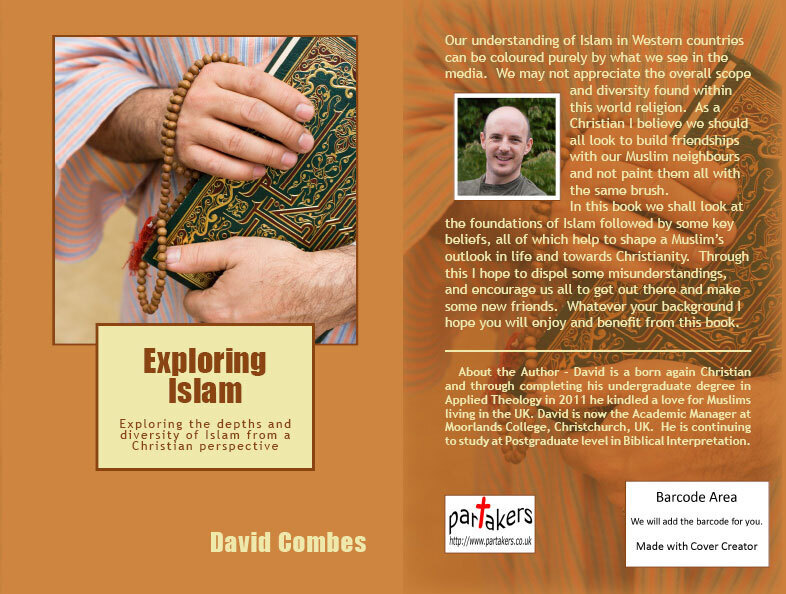
G’day and welcome to Partakers Christian Podcasts! Join us for uplifting Bible teaching, inspiring readings, heartfelt worship, powerful prayers, and fascinating church history. Whether you’re new to faith or growing deeper in your journey, we’re here to encourage and equip you. 🎧 Tune in, interact, and be inspired—wherever you are in the world.
Episodes

Monday Apr 26, 2021
Exploring Islam 07
Monday Apr 26, 2021
Monday Apr 26, 2021

Exploring Islam
7. Variety In Islam
Today we are going to look at the variety found within Islam. We can at times be tempted to think that all Muslims are alike, but as we shall see there is great diversity in the categories of Sunni, Shi’a, Sufi and Folk Islam.
Sunni and Shi’a
After Muhammad had died and the difficult process started for the people to decide a new leader the seeds of division formed which would remain in the form of Sunni and Shi’a groups. Some believers, the majority at that time, believed that a new leader could and should be chosen from the close companions of the prophet by the majority consent of the Muslim community.
As a result the Islamic empire remained superficially unified through four successive caliphs, or leaders, before this underlying disagreement took a more direct and violent turn. Through many battles the minority group who always contested that Muhammad’s successor must be from the prophet’s own blood line took arms against the majority. They never succeeded in overthrowing the empire, but instead strove forward as a distinct group who broke away from the rest.
Within Shi’ism the first genuine successor was Al-Husain the grandson of the prophet and who was brutally killed on the battle field against the Sunni in one of the final confrontations. This is commemorated each year and if you type ‘Shi’a’ into most search engines the images at the top will be of bloody processions of remembrance in Iran.
With the dismissal of the previous caliphs came the equal rejection of many Islamic traditions, Hadiths and parts of Sharia law which were instigated by them. Instead of successors being chosen by the people, Shi’ism believed that the rightful successor who had Muhammad’s blood in them also shared some mystical connection with the prophet, and hence it is only them who had the authority to lead and make choices.
In a way these subsequent leaders of the minority Islamic sect had moved on from a political successor, which is all that Sunni had, into a combined spiritual and political figurehead. Shi’a Muslims remain a minority in the world today and are found mostly in Iran, but also elsewhere. The two groups seemed to have accepted themselves, but equally on the ground there can be much animosity.
Because of the different theological foundations in Shi’ism, some of their practices are different to Sunni. Instead of praying five times a day they only do it three times. When they pray they include a stone, clay, or wooden tablet which they bow and place their head on, this is sourced from one of their different Hadiths. Because of these differences it is common for Shi’a believers to attend separate Mosques.
Sufism
Sufism is not a separate sect of Islam like Sunni or Shi’a, but instead followers can reside in either camp. The difference between them and non-Sufi lie in their awareness and specific beliefs around the nature of Allah and humanity’s ability to commune with him. For non-Sufi orthodox believers Allah is so vastly different and superior to humanity there can never be any kind of relationship or meeting between the two.
Even when in Paradise after death you are not with Allah who continues to reside elsewhere. Allah would not desire it to be otherwise, for example the Qur’an describes his disgust at the concept of him becoming a man as the Christians claim of Jesus. But for Sufis they yearned for a more otherworldly experience of Allah.
This is achieved through specific methods of prayer and meditation under the guidance of a Sufi master or teacher. They tend to emphasise the love of Allah over any other characteristic, and believe that through these activities it is possible, even if very difficult, to draw closer on a spiritual level and experience union with Allah.
This might all sound rather strange and unusual, but it is not a far cry from Eastern Orthodox Christianity’s practices and beliefs, and indeed when I pray as a Western Protestant I desire to draw close to God in some tangible way.
Folk Islam
Similar to Sufism, Folk Islam can exist within either Sunni or Shi’a groups, but primarily it is found in the former. It can equally be referred to as Popular Islam and is the combination of orthodox beliefs and practices with additional non-Islamic concepts. This is not unusual and all world religions have faced the threat of outside influences sometimes conceding ground.
One of the major concerns for people is that of sickness, death and what is to come afterwards. In times where normal medical treatment fails and orthodox Islamic belief would only provide the comfort of Allah’s predetermined and unknown will, a desire to have some influence in the situation led to the acceptance of some pre-existing religious beliefs.
For the most part these additions can be centred on the role of a shaman or wise man who is gifted with the ability to communicate with the spirits of the dead. Through this intercession and in combination with certain practices a person may be able to positively impact their difficult situation. In conjunction with this are the two opposing concepts of positive blessing versus the evil eye.
Some people, objects, locations or things are more blessed and lucky than others. Fridays are always like this and so many important business meetings or personal choices are purposefully delayed if possible to this day of the week. The evil eye on the other hand is seen as a strong negative force or spirit which resides within each person from birth. Its role is to undermine the faith and religious commitment of the believer. This is commonly seen through the act of envy and it is common in parts of Africa for newborn babies to remain within the house for as long as possible so no one is able to invoke the evil eye onto them.
What we have covered here is only a taster into the different expressions of Islam around the world today. But I hope that it has helped to expand our appreciation that what aspects we normally see in the media does not properly represent the overall diverse picture.
Sunni and Shi’a
After Muhammad had died and the difficult process started for the people to decide a new leader the seeds of division formed which would remain in the form of Sunni and Shi’a groups. Some believers, the majority at that time, believed that a new leader could and should be chosen from the close companions of the prophet by the majority consent of the Muslim community.
As a result the Islamic empire remained superficially unified through four successive caliphs, or leaders, before this underlying disagreement took a more direct and violent turn. Through many battles the minority group who always contested that Muhammad’s successor must be from the prophet’s own blood line took arms against the majority. They never succeeded in overthrowing the empire, but instead strove forward as a distinct group who broke away from the rest.
Within Shi’ism the first genuine successor was Al-Husain the grandson of the prophet and who was brutally killed on the battle field against the Sunni in one of the final confrontations. This is commemorated each year and if you type ‘Shi’a’ into most search engines the images at the top will be of bloody processions of remembrance in Iran.
With the dismissal of the previous caliphs came the equal rejection of many Islamic traditions, Hadiths and parts of Sharia law which were instigated by them. Instead of successors being chosen by the people, Shi’ism believed that the rightful successor who had Muhammad’s blood in them also shared some mystical connection with the prophet, and hence it is only them who had the authority to lead and make choices.
In a way these subsequent leaders of the minority Islamic sect had moved on from a political successor, which is all that Sunni had, into a combined spiritual and political figurehead. Shi’a Muslims remain a minority in the world today and are found mostly in Iran, but also elsewhere. The two groups seemed to have accepted themselves, but equally on the ground there can be much animosity.
Because of the different theological foundations in Shi’ism, some of their practices are different to Sunni. Instead of praying five times a day they only do it three times. When they pray they include a stone, clay, or wooden tablet which they bow and place their head on, this is sourced from one of their different Hadiths. Because of these differences it is common for Shi’a believers to attend separate Mosques.
Sufism
Sufism is not a separate sect of Islam like Sunni or Shi’a, but instead followers can reside in either camp. The difference between them and non-Sufi lie in their awareness and specific beliefs around the nature of Allah and humanity’s ability to commune with him. For non-Sufi orthodox believers Allah is so vastly different and superior to humanity there can never be any kind of relationship or meeting between the two.
Even when in Paradise after death you are not with Allah who continues to reside elsewhere. Allah would not desire it to be otherwise, for example the Qur’an describes his disgust at the concept of him becoming a man as the Christians claim of Jesus. But for Sufis they yearned for a more otherworldly experience of Allah.
This is achieved through specific methods of prayer and meditation under the guidance of a Sufi master or teacher. They tend to emphasise the love of Allah over any other characteristic, and believe that through these activities it is possible, even if very difficult, to draw closer on a spiritual level and experience union with Allah.
This might all sound rather strange and unusual, but it is not a far cry from Eastern Orthodox Christianity’s practices and beliefs, and indeed when I pray as a Western Protestant I desire to draw close to God in some tangible way.
Folk Islam
Similar to Sufism, Folk Islam can exist within either Sunni or Shi’a groups, but primarily it is found in the former. It can equally be referred to as Popular Islam and is the combination of orthodox beliefs and practices with additional non-Islamic concepts. This is not unusual and all world religions have faced the threat of outside influences sometimes conceding ground.
One of the major concerns for people is that of sickness, death and what is to come afterwards. In times where normal medical treatment fails and orthodox Islamic belief would only provide the comfort of Allah’s predetermined and unknown will, a desire to have some influence in the situation led to the acceptance of some pre-existing religious beliefs.
For the most part these additions can be centred on the role of a shaman or wise man who is gifted with the ability to communicate with the spirits of the dead. Through this intercession and in combination with certain practices a person may be able to positively impact their difficult situation. In conjunction with this are the two opposing concepts of positive blessing versus the evil eye.
Some people, objects, locations or things are more blessed and lucky than others. Fridays are always like this and so many important business meetings or personal choices are purposefully delayed if possible to this day of the week. The evil eye on the other hand is seen as a strong negative force or spirit which resides within each person from birth. Its role is to undermine the faith and religious commitment of the believer. This is commonly seen through the act of envy and it is common in parts of Africa for newborn babies to remain within the house for as long as possible so no one is able to invoke the evil eye onto them.
What we have covered here is only a taster into the different expressions of Islam around the world today. But I hope that it has helped to expand our appreciation that what aspects we normally see in the media does not properly represent the overall diverse picture.
Right Mouse click or Tap here to save this as an audio mp3 file

This series is now available to buy as a book, Kindle or paperback on Amazon :
UK/Europe - http://www.amazon.co.uk/Exploring-Islam-exploring-diversity-Christian/dp/1507774567/
USA - http://www.amazon.com/Exploring-Islam-exploring-diversity-Christian/dp/1507774567/
Click or tap on the appropriate link below to subscribe, share or download our iPhone App!![]()
![]()
![]()
![]()
![]()
![]()
![]()
Version: 20241125

No comments yet. Be the first to say something!